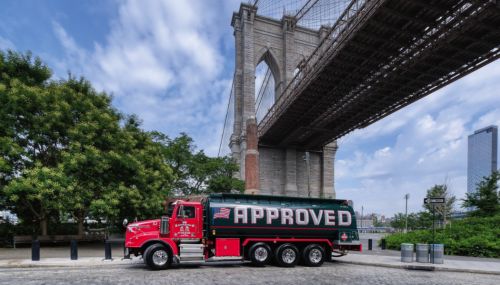All
Burner Questions? The Answer Is in Your Hands.

Manufacturers provide step-by-step guides for new B100 burners
2023 was a hot year for burner tech. Both Beckett and Carlin Combustion began production of B100-rated burners and had them available for purchase before the year was out. Both companies have recently added tools for technicians working with these new models.
Carlin Conversion Guide
Carlin’s residential oil line is UL Listed for B100. While many upgrades were made after thousands of hours of testing, the company states that those changes are subtle and serve to optimize long-term use with B100 and high biodiesel blends.
Well aware that there are many B20 and older burners still in use, Carlin has outlined the visible differences to help technicians identify if they’re working with a B100 burner. For starters, the manufacture date can tell a lot about which generation they are seeing:
- Before February 16, 2021: Burner is UL Listed for standard NO. 2 heating oil and biodiesel blends up to B5.
- February 16, 2021 through November 17, 2023: Burner is UL Listed for standard NO 2 heating oil and biodiesel blends up to B20.
- November 20, 2023 and beyond: Burner is UL Listed for standard NO 2 heating oil and biodiesel blends up to and including B100.
Carlin recognized that replacing a working burner doesn’t always make sense, so most Carlin residential oil burners manufactured before November 2023 can be converted to a B100 burner. That being said, it is important to understand the visual differences a technician will encounter when a burner has been upgraded and the simple steps it takes to convert to be ready for B100.
The company explains that if a burner is B100-ready, you will see the following:
- The combustion head assembly has a gold e-clip. Carlin has made dimensional changes to the combustion head assembly.
- The fuel pump is a B100 rated Suntec 3006 or 7116. Carlin standardized the burners with the Suntec 3006. However, some applications use the Suntec 7116 with an external valve.
- Burner should be set for OEM specs, which can be found in the Carlin Combustion Online OEM Guide.
- The control is a Pro-X 70200 with a manufactured date of 11/20/2023 or later.
- If the control is manufactured before 11/20/2023, the Pro-X 70200 should be set with the following settings:
- Flame stabilization: 5 seconds
- CAD Ohms Max: 5300
- Ignition Type: Smart Ignition
- Motor Delay Off (Post Purge): Minimum 15 seconds
- If the control is manufactured before 11/20/2023, the Pro-X 70200 should be set with the following settings:
If the burner has not been upgraded with the above, the four steps are the same. Please consult the online conversion guide to identify specific parts needed based on application at oemguide.carlincombustion.com.
Testing with high bio blends led Carlin to understand the different combustion characteristics and refine their Pro-X 70200 primary control equipment as follows:
- Carlin’s patented “Smart Ignition” feature allows for reduced ignition times to help minimize carbon formation on the combustion head, and has been designed help guard against nuisance lockouts
- Testing revealed ohms are typically elevated with high bio blends. The new CAD Ohms Max default setting accommodates this.
- Post Purge helps keep the combustion head cool after run cycles, reducing the potential for after-drip, which can cause a buildup on the combustion head
- Pro-X 70200s with a manufacture date of 11/20/2023 and later have a new ignition sequence. Technicians can expect to see changes to the Pre-Purge cycle based on the programmed setting. This new sequence reduces ignition timing to minimize carbon formation.
Carlin has spent countless hours in the lab making and evaluating changes to deliver a fully UL Listed B100 burner that technicians can trust to fire heating oil, bio blends, and B100 long-term. Detailed information on the UL Listed B100 burner is available at carlincombustion.com.
R.W. Beckett’s myTechnician™ App Unveils Enhanced Troubleshooting Capabilities
Beckett’s “fuel agnostic” burners are compatible with all blends of biodiesel and renewable diesel as well as No. 1 and No. 2 heating oil. The company offers B100 Set-Up and Recommended System Upgrade guides for existing systems on their website.
This month, the R.W. Beckett myTechnician™ app rolled out an update with integrated troubleshooting to assist technicians where they need assistance the most: troubleshooting equipment in the field.
myTechnician™ already made it easy to program a control and share data, with its integrated ability to share a full PDF report. According to the company, the enhancements were developed to reduce the learning curve for new technicians as well as aid seasoned technicians troubleshoot the issue, getting them out of the basement and on to the next site more quickly.
“Troubleshooting is a complex but critical task that requires a structured approach, leveraging training and expertise. Technology can help to identify issues and intuitively guide targeted solutions. The GeniSys® 7565 control and the new BeckettLink® Pro in conjunction with the Genisys® 7505 control help to determine the cause of faults with best-in-industry hardware and, combined with our new
integrated troubleshooting guides, can help streamline decision-making and enhance problem-solving,” explained Alan Chmiel, Director of Engineering.
Technicians can access the troubleshooting guide by simply tapping the support icon. They can streamline the troubleshooting experience by selecting the fault in the fault history screen.
“This release is the first step in enhancing our integrated troubleshooting guide. We have an 18-month plan to regularly roll out new features for troubleshooting that will enhance the technician’s experience and limit the impact to customers,” Chmiel stated.
As clean heat standards across the country require liquid heating fuel retailers to reduce their customers’ emissions and consumers require heating solutions that shrink their carbon footprint, the liquid heating fuels industry is moving toward the net-zero carbon future promised in the Providence Resolution. Higher blends of biofuels and B100/R100 renewable liquid heating fuels (RLHF) are the path to meeting all these requirements. These new B100 burners, and easily accessible guides and troubleshooting technologies, are a large part of the solution.
Related Posts
 From Blue Flame to Biofuels
From Blue Flame to Biofuels
Posted on June 25, 2025
 HEAT Show Announces Fenway Park Backyard BBQ
HEAT Show Announces Fenway Park Backyard BBQ
Posted on May 15, 2025
 Delivering New York City’s Clean Energy Solutions
Delivering New York City’s Clean Energy Solutions
Posted on May 14, 2025
 Are You a Leader or a Boss? The Choice is Yours
Are You a Leader or a Boss? The Choice is Yours
Posted on May 14, 2025
Enter your email to receive important news and article updates.
